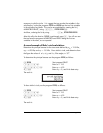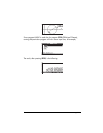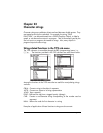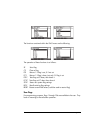
Page 23-4
screen the keystroke sequence to get such character (. for this case) and the
numerical code corresponding to the character (10 in this case).
Characters that are not defined appear as a dark square in the characters list
(
) and show (None) at the bottom of the display, even though a numerical code
exists for all of them. Numerical characters show the corresponding number at
the bottom of the display.
Letters show the code α (i.e., ~) followed by the corresponding letter, for
example, when you highlight M, you will see αM displayed at the lower left side
of the screen, indicating the use of ~m. On the other hand, m shows the
keystroke combination αM, or ~„m.
Greek characters, such as σ, will show the code α
S, or ~‚s. Some
characters, like ρ, do not have a keystroke sequence associated with them.
Therefore, the only way to obtain such characters is through the character list by
highlighting the desired character and pressing @ECHO1@ or @ECHO@.
Use @ECHO1@ to copy one character to the stack and return immediately to normal
calculator display. Use @ECHO@ to copy a series of characters to the stack. To
return to normal calculator display use $.
See Appendix D for more details on the use of special characters. Also,
Appendix G shows shortcuts for producing special characters.


















